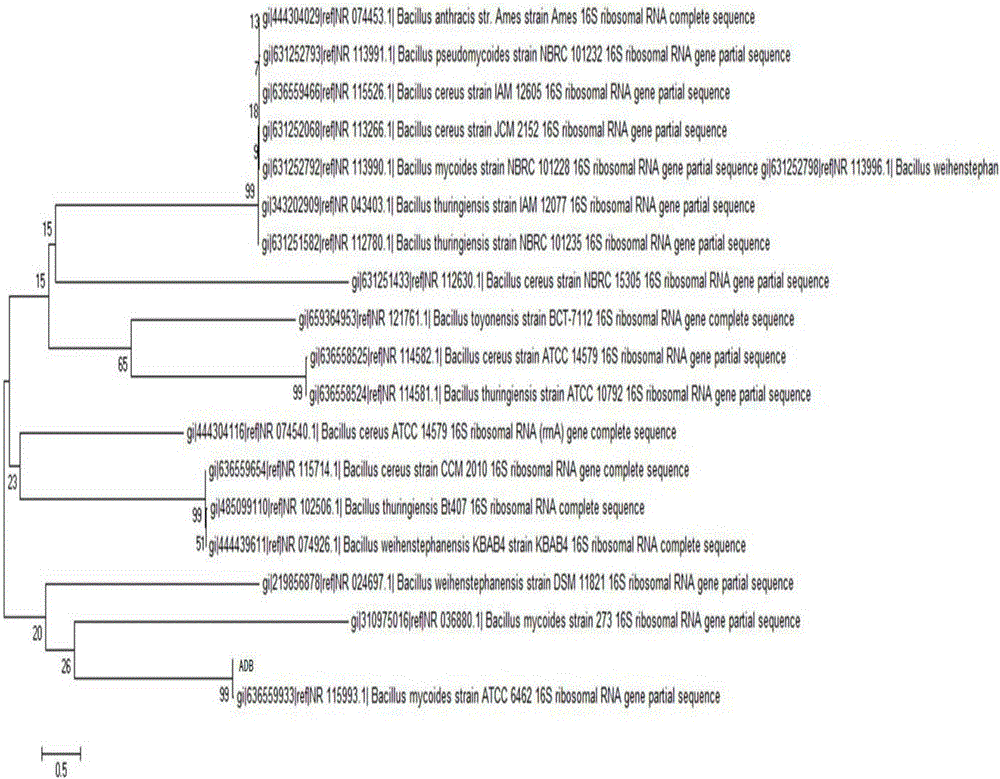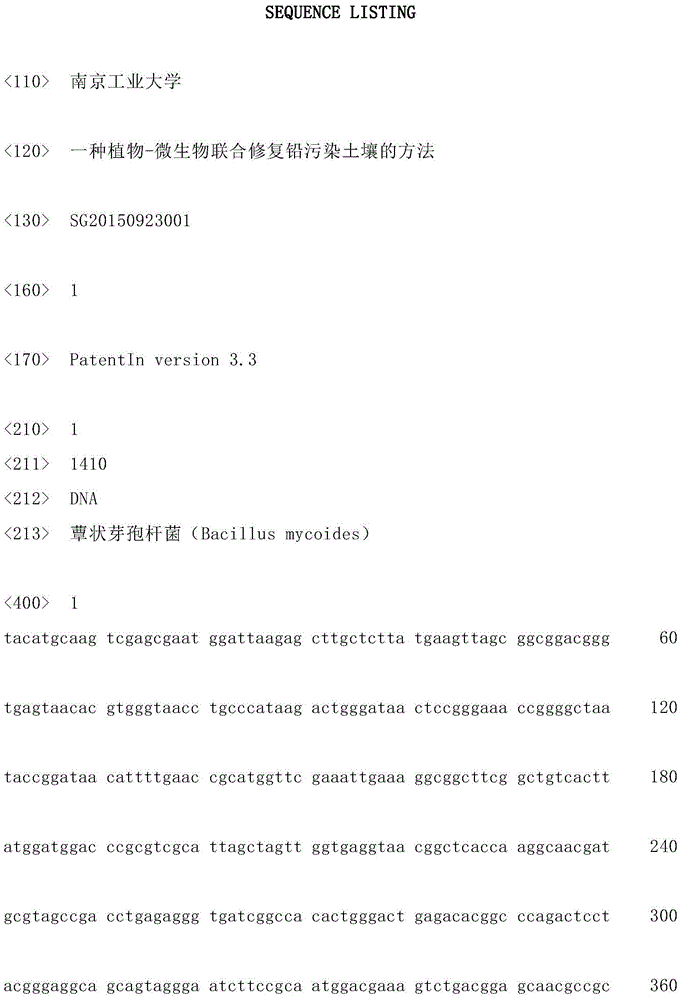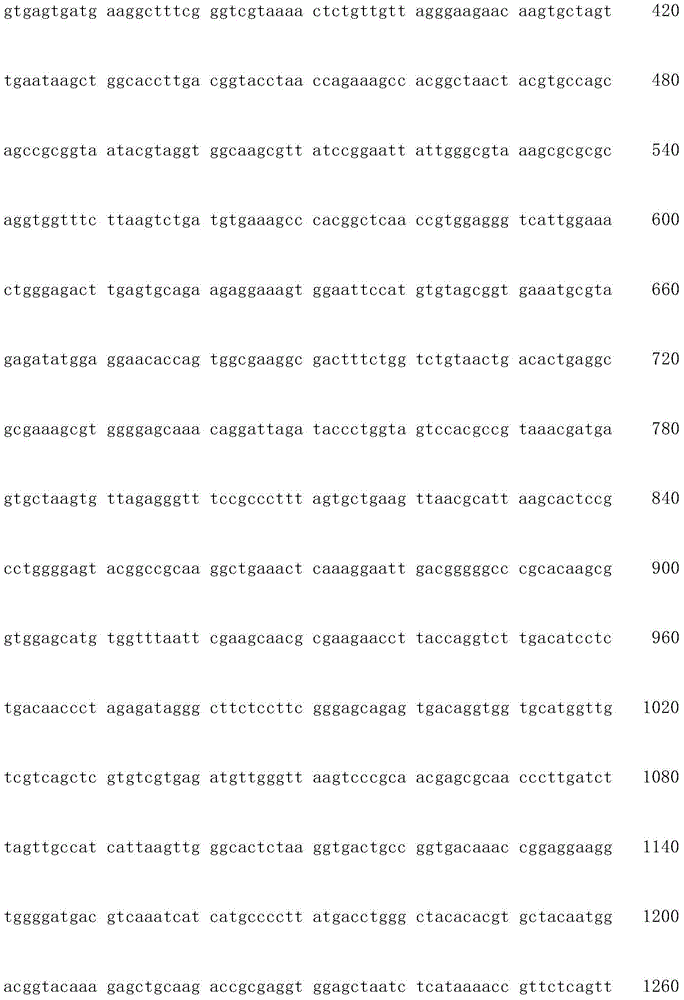Method for repairing lead-polluted soil by combination of plants and microorganisms
A lead-contaminated soil and joint remediation technology, applied in the field of environmental remediation, can solve the problems of inability to remove heavy metals, high cost, secondary pollution, etc., and achieve the effects of no secondary pollution, easy management, and improved absorption capacity.
- Summary
- Abstract
- Description
- Claims
- Application Information
AI Technical Summary
Problems solved by technology
Method used
Image
Examples
Embodiment 1
[0031] Example 1: Screening, identification and biological characteristics analysis of Bacillus mycoides ADB.
[0032] 1) Soil sample source: Activated sludge from an electroplating sludge factory in Nanjing
[0033] 2) Strain screening: Take 1g of activated sludge and add it to 10ml of liquid LB medium (peptone 10g / L, sodium chloride 10g / L, yeast powder 5g / L.) Enrichment culture, culture conditions 37 ℃ 180r / min, cultivated for 24 hours; take 1ml of the enriched culture solution and inoculate it in the fresh liquid medium containing 100mg / L lead, culture at 37°C and 180r / min; / L metal ion liquid medium, increase the metal ion concentration step by step. Then use the inoculation loop to take the culture solution with the highest tolerated concentration and inoculate it on the solid plate containing 100mg / L lead ion, and incubate at 37℃ for 24h. According to the colony morphology on the plate, single colonies were picked and inoculated into the lead ion selection medium for ...
Embodiment 2
[0039] Embodiment 2: the preparation of microbial compound bacterial agent.
[0040] The preparation method of bacterial agent in the present invention specifically comprises the following steps:
[0041] (1) Mix 5 g of beef extract, 10 g of peptone, 5 g of NaCl and 1 L of distilled water, adjust the pH value to 7.0, and sterilize to obtain a culture medium;
[0042] (2) transfer the strains preserved in the slant culture medium to inoculate the culture medium respectively, and cultivate them for 48 hours at a temperature of 37° C. and a rotation speed of 250 r / min;
[0043](3) Mix the strains obtained in step (2) according to the ratio, add them again to the culture medium prepared in step (1) to amplify together, and expand the culture for 48 hours at a temperature of 37°C and a rotation speed of 250r / min , to obtain the fermentation liquid;
[0044] (4) Mix the bran sterilized and cooled in advance according to the mass ratio of 30:1 to the fermented liquid, air-dry it na...
Embodiment 3
[0046] Example 3: The enrichment ability of lead in soil by different combinations of Indian mustard and microbial agents.
[0047] The experiment uses a plastic pot with a diameter of about 10cm, and each pot is filled with about 1kg of soil. After the soil is air-dried, it passes through a 2mm sieve. The heavy metal cadmium is added to the pot in the form of a solution and mixed evenly. The amount of water is 80% of the maximum water holding capacity in the field. After a week of natural balance, Indian mustard seeds are sprinkled in the pots, and the seeding rate is 4g / m 2 , the upper part is covered with soil 1cm, and after 10 days of plant growth, the experiment of each treatment group is started, and the total amount of the experimental group with microbial agent is 2Kg / m 2 .
[0048] in,
[0049] Group 1 consisted of Indian mustard only, without adding any microorganisms.
[0050] Group 2 was Indian mustard + Bacillus mycoides.
[0051] Group 3 is Indian mustard + S...
PUM
 Login to View More
Login to View More Abstract
Description
Claims
Application Information
 Login to View More
Login to View More - R&D
- Intellectual Property
- Life Sciences
- Materials
- Tech Scout
- Unparalleled Data Quality
- Higher Quality Content
- 60% Fewer Hallucinations
Browse by: Latest US Patents, China's latest patents, Technical Efficacy Thesaurus, Application Domain, Technology Topic, Popular Technical Reports.
© 2025 PatSnap. All rights reserved.Legal|Privacy policy|Modern Slavery Act Transparency Statement|Sitemap|About US| Contact US: help@patsnap.com



